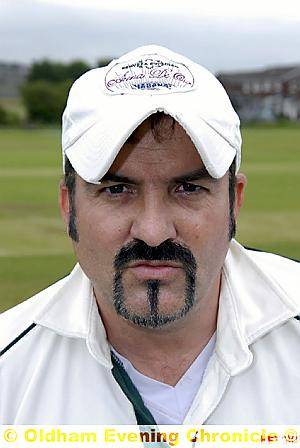Wet, wet, wet: Reflections on rain-lashed season
Reporter: Kevin Richardson
Date published: 25 September 2008

MARK BARNES: Rejuvenated Heyside.
Armstrongs Office Furniture Saddleworth and District Cricket League
WITH my big overcoat put away and my gloves back in the drawer, it is time to look back on the Armstrongs Office Furniture Saddleworth and District Cricket League season.
It will be best remembered for the weather — I’ve got three bottles of factor 30 sun cream, unused, if anybody wants them — which is unfortunate after a thrilling conclusion to the title race and Heyside’s unexpected triumph in the Tanner Cup final.
I will sum up the season in three categories . . . the good, the bad and the ugly.
THE GOOD
It was no surprise Bamford Fieldhouse took the title, but no-one expected them to be run so close by rejuvenated Heyside, inspired by old hands Mark Barnes and Tony Heaton and professional Roelof Hugo.
Andy Barton’s Bamford deserve praise because, at one stage during the season, they were more than 40 points adrift of Heyside.
Barton is already making plans for 2009, with the acquisition of new professional Stephen Parry from Lancashire and Crompton captain Simon Wright.
Heyside, who would get their revenge in the Tanner Cup final, finished in front of Moorside, Uppermill and Austerlands.
Moorside were expected to go well — the Turf Pit Lane outfit are on the look-out for a professional after Alan Durose turned down a new offer — but it was a welcome sight to see Uppermill and Austerlands in the top five.
Zeeshan Khan proved to be an inspired signing for Uppermill, the overseas amateur scoring more than 1,000 runs.
Matt Taylor’s side won seven games on the trot mid-way through the season and harboured hopes of winning the whole thing after beating Bamford.
Austerlands carried on where they left off in 2007 — they were beaten finalists in the Tanner Cup — to finish fifth under captain Kevin Du Feu.
With a burgeoning junior set up and the ground in top order, they will be looking to carry on the good work.
Austerlands are also in the market for a new paid man to replace West Indian Donwell Hector.
Glodwick can also look forward with optimism.
After a difficult first season in the league — they finished second bottom — their Warren Lane ground was finally given the all-clear to stage games and results picked up.
Only the elements denied pro Imran Aslam 100 wickets, but he will return next spring to try to reach his goal.
It was great to see Hollinwood pro Aamir Bashir playing cricket again after recovering from serious illness.
Hopefully, the popular Pakistani, who scored his 10,000th run in the league this year, will be back to his best in 2009.
THE BAD
The weather. Twelve out of 24 days of league cricket were affected by rain, but only three days were washed out entirely.
High winds forced the Moorside versus Heyside Tanner Cup tie to be postponed, while it took five attempts to play the final.
Friarmere were unable to complete any of their last eight games, five of which did not even start.
Hollinwood’s title hopes were ended in one hit when they were deducted 148 points for unwittingly fielding an ineligible player, Abdul Aqeel.
Ryan Nurse received a seven-game ban — he got three games from Greenfield — for using foul and abusive language towards an umpire and knocking down his stumps. He was later sacked by his club.
THE UGLY
Just bear with me a moment with this one.
The character Tuco is ‘The Ugly’ in Sergio Leone’s epic western, “The Good, The Bad, and The Ugly”.
He is a comical, fast-talking bandit.
Unfortunately, there is nothing remotely funny about a small band of Heyside cricket watchers — I refuse to call them supporters — who have made their mark on two cup finals for all the wrong reasons.
Fast-talking, yes, and I welcome a bit of friendly banter and encouragement, but foul language in the presence of women and children, together with abuse directed at players and officials is bang out of order.
The club can reflect on a brilliant season but, in some people’s eyes, their efforts have been overshadowed by the behaviour on the other side of the boundary rope.




